In the ever-evolving landscape of technology, on-demand applications have emerged as the cornerstone of convenience and efficiency. As we stride into 2024, the realm of on-demand services continues to burgeon with innovation, offering a plethora of opportunities for entrepreneurs to carve their niche in the market.
With the advent of cutting-edge technologies and shifting consumer preferences, the stage is set for the birth of next-generation on-demand apps that not only cater to immediate needs but also redefine user experiences. In this era of digital transformation, the journey toward profitable startups hinges on the ability to identify untapped demands, harness emerging technologies, and deliver seamless solutions that resonate with the modern consumer.
Join us as we explore the landscape of on-demand app development, charting a course toward success in the dynamic entrepreneurial ecosystem of 2024.
What is On-demand App Development?
On-demand app development refers to the creation of mobile applications that facilitate immediate access to goods, services, or information whenever users require them. These apps typically connect users with providers or suppliers in real-time, enabling them to request and receive what they need swiftly and conveniently.
On-demand apps can be used for a variety of purposes, including business-to-consumer (B2C), business-to-business (B2B), and consumer-to-consumer (C2C).
On-Demand Apps: A Statistical Overview
On-demand apps have revolutionized various industries by providing convenient access to goods and services at the tap of a screen. From transportation and food delivery to household services and healthcare, these apps have reshaped consumer behavior and business models.
This statistical overview provides insights into the growth, usage, and impact of on-demand apps across different sectors.
- In 2020, 86.5 million Americans used on-demand services, which is 42% of the total adult population.
- 50% of users actively use on-demand apps.
- The on-demand mobile app market global revenue increased to $318 billion in 2020 and is projected to reach $335 billion by 2025.
- On-demand users spend an average of $57.6 billion annually.
- 49% of on-demand consumers are millennials.
- 79% of existing on-demand users work for the same industry part-time.
- As of 2022, approximately 86.5 million Americans had used an on-demand service at least once.
- The average American spends 4.2 hours per month on on-demand service apps.
- Millennials and Gen Z are the primary users of on-demand apps, with 74% of Millennials and 79% of Gen Z reporting regular usage.
Benefits of On-demand App Development
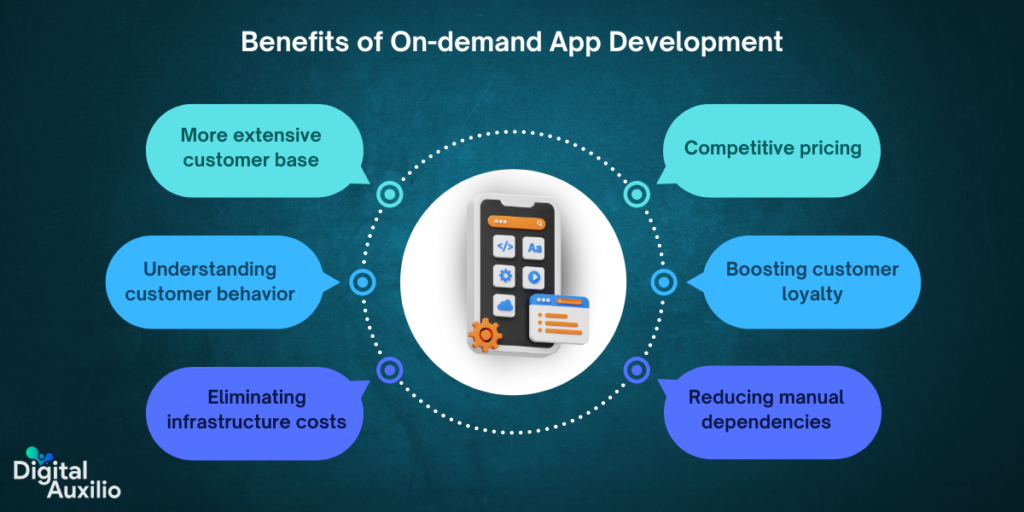
On-demand app development offers businesses the opportunity to meet evolving consumer demands swiftly and efficiently.
By providing instant access to products and services, these apps enhance customer satisfaction, streamline operations, and foster brand loyalty. Leveraging cutting-edge technology, on-demand apps empower businesses to adapt to market trends and scale their operations seamlessly.
Here are some of the benefits of on-demand app development.
1. More extensive customer base:
By providing services at the fingertips of users through on-demand apps, businesses can reach a broader audience, including those in remote or underserved areas.
2. Competitive pricing:
On-demand apps often streamline processes and reduce overhead costs, allowing businesses to offer competitive pricing compared to traditional brick-and-mortar establishments.
3. Understanding customer behavior:
On-demand apps collect valuable data on user preferences, behavior, and patterns, enabling businesses to gain insights into their customers’ needs and tailor offerings accordingly.
4. Boosting customer loyalty:
With personalized experiences, efficient service delivery, and convenient access, on-demand apps foster customer satisfaction and loyalty, leading to repeat business and positive word-of-mouth referrals.
5. Eliminating infrastructure costs:
Unlike traditional business models that require physical infrastructure, on-demand apps leverage existing digital platforms, significantly reducing the need for costly investments in property, equipment, and maintenance.
6. Reducing manual dependencies:
On-demand apps automate various processes, minimizing manual interventions and dependencies, which not only enhances operational efficiency but also reduces the likelihood of errors and delays.

Best On-demand App Development Ideas
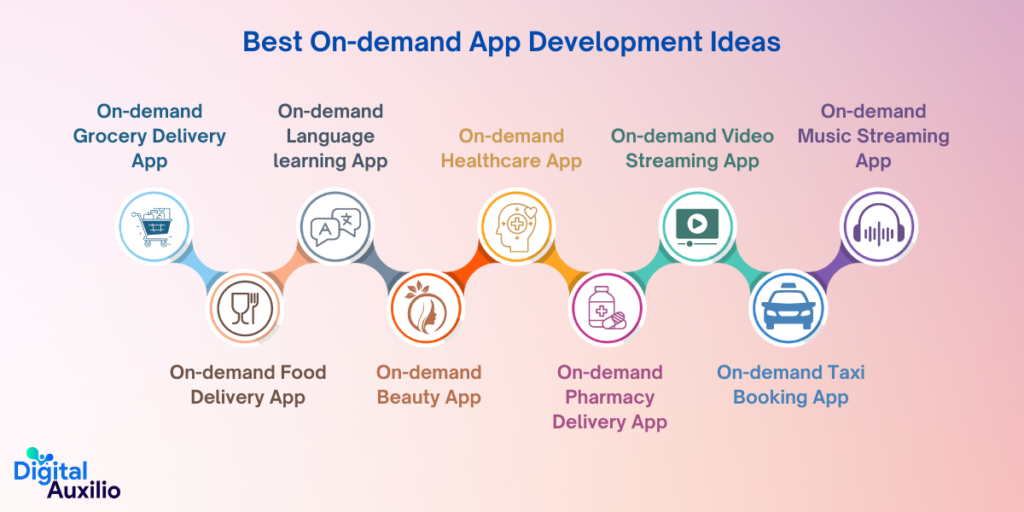
In today’s fast-paced world, the demand for on-demand services is skyrocketing. From food delivery to transportation, people crave convenience at their fingertips. Developing on-demand apps tailored to specific needs presents a lucrative opportunity for entrepreneurs.
Here we will explore innovative ideas for on-demand app development, catering to various sectors and addressing evolving consumer preferences.
1. On-demand Grocery Delivery App:
Grocery delivery apps have seen a significant surge in demand, especially during the COVID-19 pandemic, as people seek convenient and safe ways to shop for essential items. Here’s an overview of the idea along with statistics, features, and a live example:
Explanation:
With busy lifestyles and the convenience of technology, consumers increasingly prefer to order groceries online and have them delivered to their doorstep. A grocery delivery app provides a platform where users can browse through a wide range of products, place orders, and schedule deliveries according to their convenience.
Statistics:
- According to a report by Statista, the online grocery market is expected to reach $29.7 billion in the United States alone by 2021.
- During the COVID-19 pandemic, there was a significant increase in online grocery sales, with a 230% surge in demand in certain regions, as reported by Adobe Analytics.
- A survey by Brick Meets Click found that 31% of U.S. households used online grocery delivery or pickup services in August 2020, up from 13% in August 2019.
Features:
- User-friendly interface for easy browsing and navigation.
- Comprehensive product listings with images, descriptions, and prices.
- Search and filter options for quick product discovery.
- Secure payment gateways for smooth transactions.
- Multiple delivery options including same-day delivery, scheduled delivery slots, and express delivery.
- Integration with GPS for accurate tracking of orders in real-time.
- Customer support and feedback system for resolving queries and improving service.
- Loyalty programs and discounts to retain customers and encourage repeat orders.
- Inventory management system to ensure stock availability and timely updates.
Example:
One of the leading examples of a successful grocery delivery app is Instacart. Instacart allows users to shop from their favorite local stores and have their groceries delivered to their doorstep in as little as an hour.
It offers a wide range of products, flexible delivery options, and personalized recommendations based on user preferences. Instacart has gained widespread popularity and trust among consumers, making it a prime example of the potential success of a grocery delivery app.
2. On-demand Food Delivery App:
Food delivery apps have revolutionized the way people order and enjoy food, providing a convenient solution for those who prefer to dine in the comfort of their homes or offices. A food delivery app connects users with a wide range of restaurants, allowing them to browse menus, place orders, and have food delivered to their location.
Statistics:
- According to Statista, the revenue in the Online Food Delivery segment is projected to reach $151.5 billion worldwide in 2021, with a CAGR of 7.5% from 2021 to 2025.
- Research conducted by Cowen and Company indicates that food delivery sales in the United States could surpass $200 billion by 2025.
Features:
- User-friendly interface for easy browsing and ordering.
- Extensive restaurant listings with menus, reviews, and ratings.
- Search and filter options based on cuisine, price, rating, etc.
- Secure payment gateways supporting multiple payment methods.
- Real-time order tracking to monitor the status of deliveries.
- Customizable delivery options including scheduled delivery times.
- In-app customer support for resolving queries and issues.
- Loyalty programs and discounts to incentivize repeat orders.
- Integration with GPS for accurate delivery address input and tracking.
Example:
A prominent example of a successful food delivery app is DoorDash. DoorDash allows users to explore a variety of cuisines from local restaurants, fast food chains, and even grocery stores. It offers features like real-time tracking, scheduled deliveries, and DashPass, a subscription service for discounted delivery fees. DoorDash’s widespread availability, diverse restaurant options, and user-friendly interface have contributed to its popularity and success in the food delivery market.
3. On-demand Language learning App:
Language learning apps have become increasingly popular as people seek convenient and flexible ways to acquire new language skills. These apps provide interactive platforms where users can learn languages at their own pace, anytime and anywhere, through various exercises, lessons, and activities.
Statistics:
- According to Statista, the global language learning market size was valued at approximately $18.66 billion in 2020 and is projected to reach $37.69 billion by 2027, with a CAGR of 10.7% from 2020 to 2027.
- Duolingo, one of the leading language learning apps, reported over 500 million total downloads and over 30 million monthly active users as of 2021.
Features:
- User-friendly interface with intuitive navigation and design.
- Multi-language support to cater to a diverse user base.
- Structured lessons covering vocabulary, grammar, pronunciation, and more.
- Interactive exercises including quizzes, games, and speaking practice.
- Personalized learning plans based on user proficiency levels and learning goals.
- Progress tracking and performance analytics to monitor learning achievements.
- Audio and visual aids such as audio recordings, videos, and flashcards.
- Social features like language communities, forums, and peer-to-peer practice.
- Offline mode for learning on the go without internet connectivity.
- Integration with speech recognition technology for pronunciation feedback.
Example:
An exemplary language learning app is Babbel. Babbel offers courses in 14 different languages, providing learners with interactive lessons designed by language experts. It utilizes a combination of audio, visual, and interactive exercises to engage users and facilitate effective language learning. Babbel’s structured curriculum, personalized approach, and user-friendly interface have contributed to its popularity among language learners worldwide.
4. On-demand Beauty App:
An on-demand beauty app offers a convenient platform for users to book various beauty services at their preferred location and time. This innovative solution caters to individuals looking for hairstyling, makeup, skincare, and other beauty treatments without the hassle of visiting a salon or spa.
Statistics:
- The global beauty and personal care market size was valued at $511 billion in 2021 and is expected to reach $716 billion by 2025, according to Statista.
- The on-demand beauty services market is experiencing rapid growth, fueled by factors such as busy lifestyles, increasing disposable income, and the desire for personalized beauty experiences.
- According to Grand View Research, Inc., the global on-demand beauty services market size was valued at $53.7 billion in 2020 and is projected to reach $344.9 billion by 2028, growing at a CAGR of 28.9% from 2021 to 2028.
Features:
- User-friendly interface for easy booking and navigation.
- Comprehensive service listings including haircuts, manicures, facials, massages, and more.
- Profile pages for beauty professionals showcasing their expertise, portfolios, and customer reviews.
- Booking options for same-day or scheduled appointments based on user preferences.
- Location-based search to find nearby beauty professionals available for services.
- Secure payment processing with multiple payment methods.
- Rating and review system for users to provide feedback on service quality.
- Customizable preferences for specific beauty treatments, styles, or products.
- Loyalty programs and promotions to incentivize repeat bookings.
- In-app messaging for communication between users and beauty professionals.
Example:
A notable example of an on-demand beauty app is Glamsquad. Glamsquad offers a range of beauty services including hair, makeup, and nails, delivered by licensed beauty professionals directly to users’ homes, offices, or hotels. With a focus on convenience and quality, Glamsquad has gained popularity among users seeking professional beauty services on-demand.
5. On-demand Healthcare App:
An on-demand healthcare app provides users with access to various healthcare services and medical professionals from the convenience of their smartphones or tablets. This innovative platform offers timely medical assistance, remote consultations, prescription management, and other healthcare-related services.
Statistics:
- The global telemedicine market size was valued at $41.4 billion in 2020 and is projected to reach $192.8 billion by 2025, with a compound annual growth rate (CAGR) of 36.3% during the forecast period, according to MarketsandMarkets.
- A survey by McKinsey & Company found that the use of telehealth among US consumers surged from 11% in 2019 to 46% in 2020, with 76% of respondents expressing satisfaction with their telehealth experience.
Features:
- User-friendly interface for easy navigation and access to services.
- Secure patient profiles for storing medical history, prescriptions, and health records.
- Appointment scheduling for virtual consultations with healthcare providers.
- Video conferencing and chat functionalities for remote consultations.
- Symptom checker and triage tool for assessing health conditions and determining the need for medical attention.
- Prescription management and medication reminders for timely refills and dosage adherence.
- Integration with wearable devices and health monitoring tools for tracking vital signs and health metrics.
- Telepsychiatry and mental health support services for counseling and therapy sessions.
- In-app pharmacy services for ordering prescription medications and over-the-counter products.
- Emergency response features for connecting users with nearby healthcare facilities and emergency services.
Example:
A prominent example of an on-demand healthcare app is Teladoc Health. Teladoc offers virtual healthcare services including medical consultations, mental health counseling, and dermatology visits, accessible via mobile app or web platform. With a network of licensed healthcare professionals, Teladoc provides convenient and timely healthcare services to users across various specialties.
6. On-demand Pharmacy Delivery App:
An on-demand pharmacy delivery app offers a convenient solution for users to order prescription medications and over-the-counter products for delivery to their doorstep. This platform provides access to a wide range of pharmaceutical products and healthcare essentials, ensuring timely delivery and seamless user experience.
Statistics:
- The global online pharmacy market size was valued at $49.7 billion in 2020 and is expected to reach $177.8 billion by 2026, with a compound annual growth rate (CAGR) of 20.9% during the forecast period, according to Grand View Research.
- A survey by McKinsey & Company found that 48% of US consumers used online pharmacy services during the pandemic, compared to 20% pre-pandemic.
Features:
- User-friendly interface for browsing products, placing orders, and tracking deliveries.
- Comprehensive product listings including prescription medications, vitamins, supplements, personal care products, and more.
- Secure prescription upload and verification process for ordering prescription medications.
- Prescription refill reminders and automatic refill services for ongoing medication management.
- Flexible delivery options include same-day delivery, scheduled deliveries, and express shipping.
- Integration with GPS for real-time tracking of delivery status and estimated arrival time.
- Secure payment processing with multiple payment methods including credit/debit cards, digital wallets, and insurance coverage.
- In-app consultation services with licensed pharmacists for medication-related queries and counseling.
- Loyalty programs and discounts to incentivize repeat orders and customer retention.
- Customer support and feedback system for resolving issues and improving service quality.
Example:
A notable example of an on-demand pharmacy delivery app is Capsule. Capsule offers prescription delivery services in select cities, providing users with a seamless and convenient way to order medications online and have them delivered to their doorstep. With features like prescription management, automatic refills, and same-day delivery, Capsule has gained popularity among users seeking hassle-free pharmacy services.
7. On-demand Video Streaming App:
An on-demand video streaming app provides users with access to a vast library of movies, TV shows, documentaries, and other video content that can be streamed instantly on various devices. This platform allows users to browse, discover, and watch their favorite content anytime, anywhere, offering convenience and flexibility in entertainment consumption.
Statistics:
- The global video streaming market size was valued at $42.6 billion in 2020 and is projected to reach $184.3 billion by 2027, with a compound annual growth rate (CAGR) of 20.4% during the forecast period, according to Grand View Research.
- According to a survey by Statista, 55% of respondents in the United States subscribed to at least one video streaming service in 2020, with Netflix being the most popular choice.
Features:
- User-friendly interface for easy navigation and content discovery.
- Extensive content library with a diverse selection of movies, TV shows, original series, documentaries, and more.
- Personalized recommendations based on user preferences, viewing history, and behavior.
- Multiple streaming quality options including standard definition (SD), high definition (HD), and 4K Ultra HD.
- Offline viewing mode for downloading content and watching it offline without an internet connection.
- Customizable user profiles with individual watchlists, viewing preferences, and parental controls.
- Seamless cross-device synchronization for continuity of viewing experience across smartphones, tablets, smart TVs, and computers.
- Integration with social media platforms for sharing content recommendations, reviews, and viewing experiences.
- In-app subscription options with flexible pricing plans and payment methods.
- Continuous content updates and new releases to keep the library fresh and engaging.
Example:
One of the most prominent examples of an on-demand video streaming app is Netflix. Netflix offers a vast collection of movies, TV shows, documentaries, and original series that can be streamed on various devices. With features like personalized recommendations, offline viewing, and simultaneous streaming on multiple devices, Netflix has become a leading player in the video streaming industry, attracting millions of subscribers worldwide.
8. On-demand Taxi Booking App
An on-demand taxi booking app connects passengers with nearby drivers for convenient and reliable transportation services. This platform enables users to book rides, track their drivers in real-time, and make secure payments, offering a seamless and efficient solution for urban mobility.
Statistics:
- The global ride-hailing market size was valued at $75.39 billion in 2020 and is projected to reach $185.10 billion by 2026, with a compound annual growth rate (CAGR) of 16.4% during the forecast period, according to Grand View Research.
- According to a report by Statista, the number of ride-hailing users worldwide is expected to reach 1.83 billion by 2024.
Features:
- User-friendly interface for easy booking and navigation.
- Location-based services for automatic detection of user’s current location.
- Multiple ride options including economy, premium, and shared rides.
- Real-time driver tracking with estimated time of arrival (ETA) updates.
- In-app messaging and calling for communication between passengers and drivers.
- Secure payment processing with multiple payment methods including credit/debit cards, digital wallets, and cash.
- Fare estimation and upfront pricing for transparency and cost predictability.
- Safety features such as driver background checks, ride verification codes, and emergency assistance buttons.
- Ratings and reviews system for passengers to provide feedback on driver performance and overall ride experience.
- Integration with mapping and navigation services for optimized route planning and navigation.
Example:
A leading example of an on-demand taxi booking app is Uber. Uber offers ride-hailing services in cities worldwide, allowing users to book rides with a few taps on their smartphones. With features like real-time tracking, upfront pricing, and driver ratings, Uber has become synonymous with on-demand transportation, revolutionizing the way people travel in urban areas.
9. On-demand Music Streaming App
An on-demand music streaming app allows users to access a vast library of songs, albums, playlists, and podcasts for instant streaming on various devices. This platform offers a personalized and immersive music experience, enabling users to discover new music, create custom playlists, and enjoy their favorite tracks anytime, anywhere.
Statistics:
- The global music streaming market size was valued at $20.9 billion in 2020 and is projected to reach $76.9 billion by 2027, with a compound annual growth rate (CAGR) of 17.8% during the forecast period, according to Grand View Research.
- According to a report by Statista, the number of music streaming subscribers worldwide is expected to reach 948.3 million by 2026.
Features:
- User-friendly interface for easy navigation and content discovery.
- Extensive music library with millions of songs across various genres, languages, and artists.
- Personalized recommendations based on user listening habits, preferences, and history.
- Curated playlists, radio stations, and mood-based recommendations for effortless music discovery.
- Offline listening mode for downloading music and listening offline without an internet connection.
- Customizable playlists and queue management for organizing and creating personalized music collections.
- High-quality audio streaming options including standard, high-definition, and lossless audio formats.
- Integration with social media platforms for sharing music, playlists, and listening activities with friends and followers.
- In-app concert and event listings for discovering live music performances and events.
- Subscription options with ad-free listening, offline downloads, and additional features.
Example:
One of the most popular on-demand music streaming apps is Spotify. Spotify offers a vast music library with millions of songs, personalized recommendations, curated playlists, and podcasts. With features like Discover Weekly, Release Radar, and Daily Mixes, Spotify provides users with a tailored music experience, making it a leading player in the music streaming industry.
Steps for On-Demand App Development
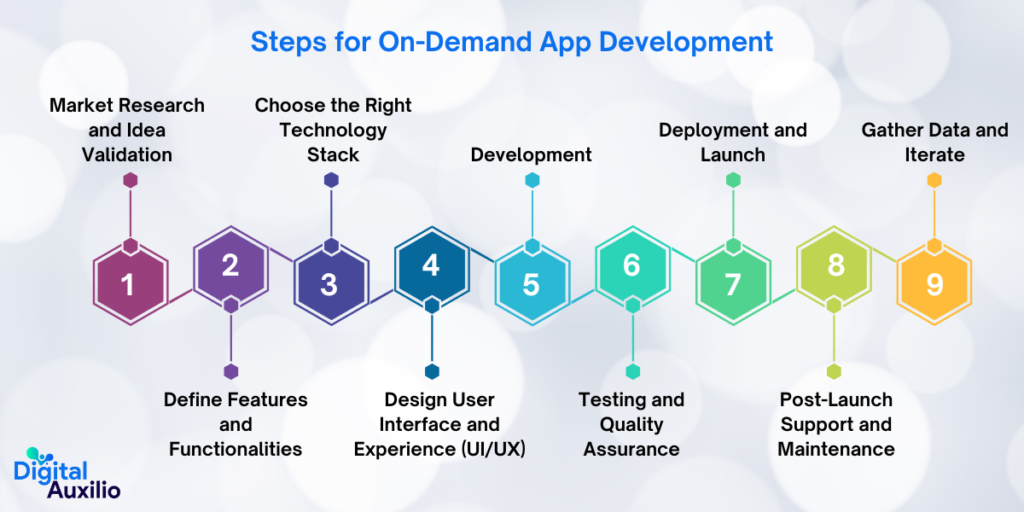
Developing an on-demand app involves several key steps to ensure its success. Here’s a comprehensive guide to help you navigate through the process:
1. Market Research and Idea Validation:
- Identify your target audience and their needs.
- Analyze competitors and existing on-demand apps in your niche.
- Validate your app idea through surveys, interviews, or MVP (Minimum Viable Product) testing.
2. Define Features and Functionalities:
- List down essential features based on user requirements and market trends.
- Prioritize features based on their importance and feasibility.
- Ensure the app is user-friendly and intuitive.
3. Choose the Right Technology Stack:
- Select appropriate technologies for front-end, back-end, and database development.
- Consider factors like scalability, security, and platform compatibility.
- Opt for frameworks and tools that expedite development without compromising quality.
4. Design User Interface and Experience (UI/UX):
- Create wireframes and prototypes to visualize app flow and interactions.
- Focus on simplicity, consistency, and accessibility in design.
- Incorporate feedback from usability testing to refine the UI/UX.
5. Development:
- Divide development into sprints or iterations for better management.
- Implement features according to the defined roadmap.
- Conduct regular code reviews and testing to maintain code quality.
- Ensure integration with third-party services like payment gateways, maps, and notifications.
6. Testing and Quality Assurance:
- Perform various types of testing, including functional, usability, performance, and security testing.
- Fix bugs and issues promptly to ensure a smooth user experience.
- Utilize automated testing tools to streamline the testing process and improve efficiency.
7. Deployment and Launch:
- Prepare for app store submission by adhering to platform guidelines and requirements.
- Set up necessary infrastructure for hosting and deployment.
- Plan a marketing strategy for the app launch to generate initial traction and user engagement.
8. Post-Launch Support and Maintenance:
- Monitor app performance and user feedback post-launch.
- Release updates and new features regularly to enhance user experience and stay competitive.
- Provide timely customer support to address user queries and issues.
9. Gather Data and Iterate:
- Utilize analytics tools to gather insights into user behavior and app performance.
- Use data-driven decision-making to prioritize future enhancements and iterations.
- Continuously iterate and improve the app based on user feedback and market dynamics.

How Much Does On-Demand App Development Cost?
The cost of developing an on-demand app can vary significantly depending on various factors such as features, complexity, platform, development team rates, and location. However, to provide you with a rough estimate, let’s break down the development process into stages and assign approximate costs:
- Discovery and Planning: This stage involves understanding your requirements, market research, and creating a project plan. Cost: $5,000 – $10,000
- UI/UX Design: Designing the user interface and user experience to ensure an intuitive and appealing app. Cost: $5,000 – $20,000
- Frontend Development: Building the frontend of the app, including features like user registration, search, and navigation. Cost: $10,000 – $30,000
- Backend Development: Developing the server, database, and APIs to support the app’s functionality. Cost: $15,000 – $40,000
- Testing and Quality Assurance: Testing the app for bugs, usability, and performance. Cost: $5,000 – $15,000
- Deployment and Launch: Deploying the app to app stores and ensuring a smooth launch. Cost: $3,000 – $8,000
- Post-Launch Support and Maintenance: Providing ongoing support, updates, and maintenance. Cost: Varies but typically around 15-20% of the total development cost annually.
Total Estimated Cost: $43,000 – $123,000
Keep in mind that these are rough estimates and actual costs may vary based on your specific requirements and the rates charged by developers. Additionally, factors like additional features, integrations, and complexities can significantly impact the overall on demand app development cost. It’s advisable to consult with a development team to get a more accurate estimate tailored to your project.
In Conclusion
As we step into 2024, the realm of on-demand applications continues to burgeon with innovation and opportunity. The path to profitable startups lies in harnessing the power of on-demand app development. By partnering with a seasoned on-demand app development company, entrepreneurs can unlock the full potential of their ideas.
The expertise of on-demand app developers is paramount in crafting user-friendly, scalable, and feature-rich applications that cater to the evolving needs of modern consumers. Whether it’s streamlining services, optimizing workflows, or enhancing user experiences, the right development team can make all the difference.
At Digital Auxilio, we offer comprehensive on-demand app development services tailored to meet the unique requirements of each client. Our commitment to excellence and client satisfaction sets us apart in the competitive landscape of custom app development.
For entrepreneurs ready to embark on their journey to success, we invite you to contact us at Digital Auxilio. Let us be your trusted partner in transforming your visionary concepts into thriving on-demand applications that drive profitability and propel your startup to new heights.
FAQs
What are on-demand apps?
On-demand apps are platforms or applications that connect users with services or products they need instantly or on short notice. These apps facilitate transactions between service providers and consumers in various industries.
Why are on-demand apps popular in 2024?
On-demand apps have gained popularity due to their convenience, accessibility, and efficiency. With the increasing reliance on smartphones and the growing expectation for instant services, on-demand apps fulfill consumers’ needs effectively.
What are some potential on-demand app ideas for 2024 startups?
Healthcare services: Apps connecting users with doctors, therapists, or healthcare professionals for virtual consultations, prescriptions, or medical advice.Remote work solutions: Platforms offering virtual office setups, project management tools, or freelance marketplaces tailored for remote work environments.Sustainable living: Apps providing eco-friendly product deliveries, recycling services, or sustainable lifestyle tips to promote environmental consciousness.Personal finance management: Applications offering budgeting tools, investment advice, or financial planning services to help users manage their finances effectively.Home services: Platforms connecting users with plumbers, electricians, cleaners, or other home service professionals for maintenance, repairs, or renovations.
How can I validate my on-demand app idea?
Validating your on-demand app idea involves conducting market research, analyzing competitors, identifying your target audience, and gathering feedback through surveys or focus groups. Additionally, building a minimum viable product (MVP) and testing it with a small group of users can help validate your concept before investing further resources.
What are the essential features of a successful on-demand app?
User-friendly interface: Intuitive design and navigation for seamless user experience.Real-time tracking: Ability for users to track service providers or deliveries in real-time.Secure payment options: Integration of secure payment gateways for seamless transactions.Rating and review system: Allows users to rate and review service providers, fostering trust and accountability.Push notifications: Keeps users informed about order status, promotions, or relevant updates.
How can I monetize my on-demand app?
Monetization strategies for on-demand apps include charging service fees, subscription models, advertising, premium features, or partnerships with businesses. Additionally, data monetization through analytics or targeted advertising can generate revenue.
What are the technological trends shaping the future of on-demand apps?
Artificial Intelligence (AI) and Machine Learning: Integration of AI for personalized recommendations, predictive analytics, and chatbots for customer support.Blockchain technology: Enhanced security, transparency, and decentralization for transactions and data management.Internet of Things (IoT): Integration of IoT devices for smart home services, asset tracking, or predictive maintenance.Augmented Reality (AR) and Virtual Reality (VR): Immersive experiences for product visualization, virtual tours, or interactive training modules.
How do I ensure the safety and security of users on my on-demand app?
Implementing robust security measures such as data encryption, secure authentication protocols, compliance with privacy regulations (e.g., GDPR), and background checks for service providers can help ensure the safety and security of users on your platform.
What are the challenges of starting an on-demand app startup in 2024?
Some challenges include intense competition, regulatory compliance, building trust with users and service providers, scaling operations efficiently, and adapting to rapidly evolving technological trends and consumer preferences.

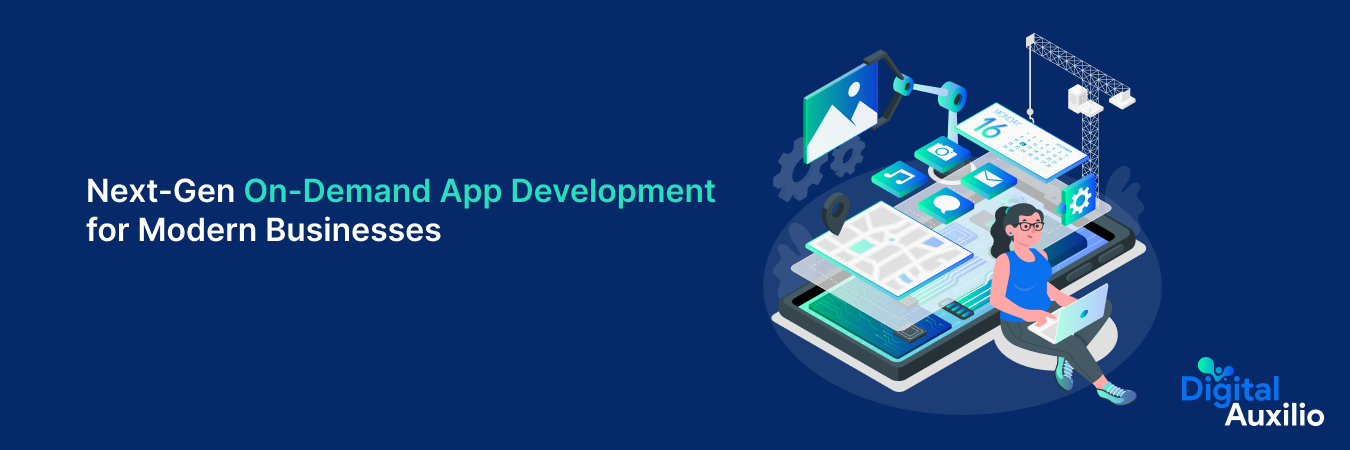
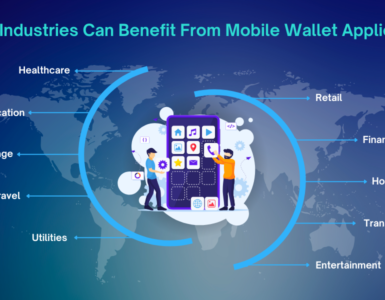




Add comment